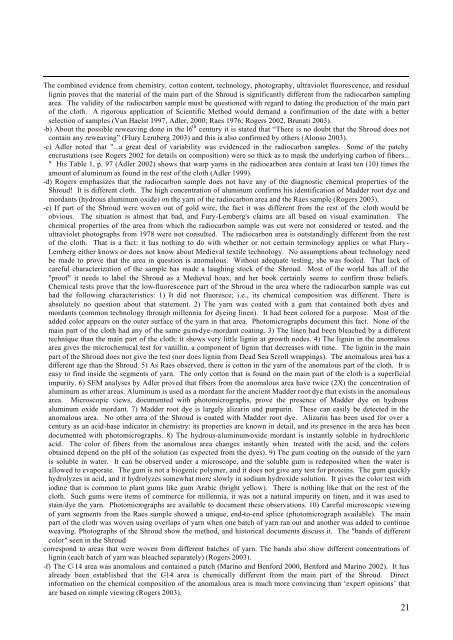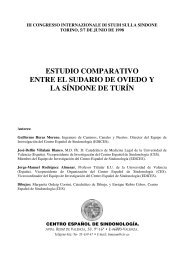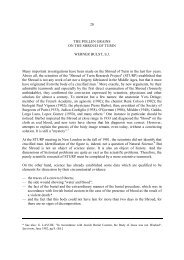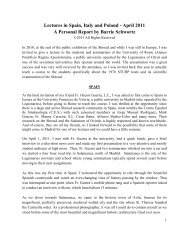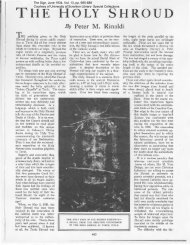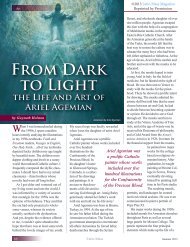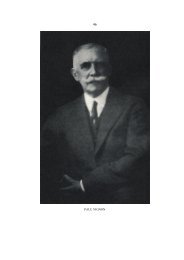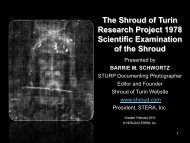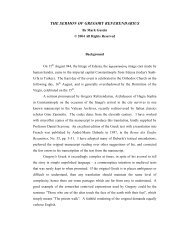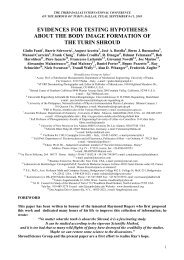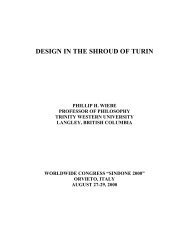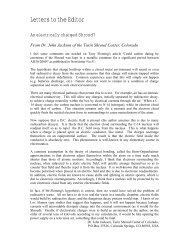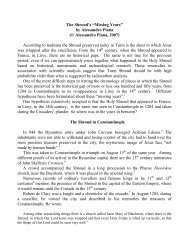list of evidences 10d Barrie - The Shroud of Turin Website
list of evidences 10d Barrie - The Shroud of Turin Website
list of evidences 10d Barrie - The Shroud of Turin Website
Create successful ePaper yourself
Turn your PDF publications into a flip-book with our unique Google optimized e-Paper software.
<strong>The</strong> combined evidence from chemistry, cotton content, technology, photography, ultraviolet fluorescence, and residuallignin proves that the material <strong>of</strong> the main part <strong>of</strong> the <strong>Shroud</strong> is significantly different from the radiocarbon samplingarea. <strong>The</strong> validity <strong>of</strong> the radiocarbon sample must be questioned with regard to dating the production <strong>of</strong> the main part<strong>of</strong> the cloth. A rigorous application <strong>of</strong> Scientific Method would demand a confirmation <strong>of</strong> the date with a betterselection <strong>of</strong> samples (Van Haelst 1997, Adler, 2000; Raes 1976; Rogers 2002, Brunati 2003).-b) About the possible reweaving done in the l6 th century it is stated that “<strong>The</strong>re is no doubt that the <strong>Shroud</strong> does notcontain any reweaving” (Flury Lemberg 2003) and this is also confirmed by others (Alonso 2003).-c) Adler noted that "...a great deal <strong>of</strong> variability was evidenced in the radiocarbon samples. Some <strong>of</strong> the patchyencrustations (see Rogers 2002 for details on composition) were so thick as to mask the underlying carbon <strong>of</strong> fibers..." His Table 1, p. 97 (Adler 2002) shows that warp yarns in the radiocarbon area contain at least ten (10) times theamount <strong>of</strong> aluminum as found in the rest <strong>of</strong> the cloth (Adler 1999).-d) Rogers emphasizes that the radiocarbon sample does not have any <strong>of</strong> the diagnostic chemical properties <strong>of</strong> the<strong>Shroud</strong>! It is different cloth. <strong>The</strong> high concentration <strong>of</strong> aluminum confirms his identification <strong>of</strong> Madder root dye andmordants (hydrous aluminum oxide) on the yarn <strong>of</strong> the radiocarbon area and the Raes sample (Rogers 2003).-e) If part <strong>of</strong> the <strong>Shroud</strong> were woven out <strong>of</strong> gold wire, the fact it was different from the rest <strong>of</strong> the cloth would beobvious. <strong>The</strong> situation is almost that bad, and Fury-Lemberg's claims are all based on visual examination. <strong>The</strong>chemical properties <strong>of</strong> the area from which the radiocarbon sample was cut were not considered or tested, and theultraviolet photographs from 1978 were not consulted. <strong>The</strong> radiocarbon area is outstandingly different from the rest<strong>of</strong> the cloth. That is a fact: it has nothing to do with whether or not certain terminology applies or what Flury-Lemberg either knows or does not know about Medieval textile technology. No assumptions about technology needbe made to prove that the area in question is anomalous. Without adequate testing, she was fooled. That lack <strong>of</strong>careful characterization <strong>of</strong> the sample has made a laughing stock <strong>of</strong> the <strong>Shroud</strong>. Most <strong>of</strong> the world has all <strong>of</strong> the"pro<strong>of</strong>" it needs to label the <strong>Shroud</strong> as a Medieval hoax, and her book certainly seems to confirm those beliefs.Chemical tests prove that the low-fluorescence part <strong>of</strong> the <strong>Shroud</strong> in the area where the radiocarbon sample was cuthad the following characteristics: 1) It did not fluoresce; i.e., its chemical composition was different. <strong>The</strong>re isabsolutely no question about that statement. 2) <strong>The</strong> yarn was coated with a gum that contained both dyes andmordants (common technology through millennia for dyeing linen). It had been colored for a purpose. Most <strong>of</strong> theadded color appears on the outer surface <strong>of</strong> the yarn in that area. Photomicrographs document this fact. None <strong>of</strong> themain part <strong>of</strong> the cloth had any <strong>of</strong> the same gum-dye-mordant coating. 3) <strong>The</strong> linen had been bleached by a differenttechnique than the main part <strong>of</strong> the cloth: it shows very little lignin at growth nodes. 4) <strong>The</strong> lignin in the anomalousarea gives the microchemical test for vanillin, a component <strong>of</strong> lignin that decreases with time. <strong>The</strong> lignin in the mainpart <strong>of</strong> the <strong>Shroud</strong> does not give the test (nor does lignin from Dead Sea Scroll wrappings). <strong>The</strong> anomalous area has adifferent age than the <strong>Shroud</strong>. 5) As Raes observed, there is cotton in the yarn <strong>of</strong> the anomalous part <strong>of</strong> the cloth. It iseasy to find inside the segments <strong>of</strong> yarn. <strong>The</strong> only cotton that is found on the main part <strong>of</strong> the cloth is a superficialimpurity. 6) SEM analyses by Adler proved that fibers from the anomalous area have twice (2X) the concentration <strong>of</strong>aluminum as other areas. Aluminum is used as a mordant for the ancient Madder root dye that exists in the anomalousarea. Microscopic views, documented with photomicrographs, prove the presence <strong>of</strong> Madder dye on hydrousaluminum oxide mordant. 7) Madder root dye is largely alizarin and purpurin. <strong>The</strong>se can easily be detected in theanomalous area. No other area <strong>of</strong> the <strong>Shroud</strong> is coated with Madder root dye. Alizarin has been used for over acentury as an acid-base indicator in chemistry: its properties are known in detail, and its presence in the area has beendocumented with photomicrographs. 8) <strong>The</strong> hydrous-aluminum-oxide mordant is instantly soluble in hydrochloricacid. <strong>The</strong> color <strong>of</strong> fibers from the anomalous area changes instantly when treated with the acid, and the colorsobtained depend on the pH <strong>of</strong> the solution (as expected from the dyes). 9) <strong>The</strong> gum coating on the outside <strong>of</strong> the yarnis soluble in water. It can be observed under a microscope, and the soluble gum is redeposited when the water isallowed to evaporate. <strong>The</strong> gum is not a biogenic polymer, and it does not give any test for proteins. <strong>The</strong> gum quicklyhydrolyzes in acid, and it hydrolyzes somewhat more slowly in sodium hydroxide solution. It gives the color test withiodine that is common to plant gums like gum Arabic (bright yellow). <strong>The</strong>re is nothing like that on the rest <strong>of</strong> thecloth. Such gums were items <strong>of</strong> commerce for millennia, it was not a natural impurity on linen, and it was used tostain/dye the yarn. Photomicrographs are available to document these observations. 10) Careful microscopic viewing<strong>of</strong> yarn segments from the Raes sample showed a unique, end-to-end splice (photomicrograph available). <strong>The</strong> mainpart <strong>of</strong> the cloth was woven using overlaps <strong>of</strong> yarn when one batch <strong>of</strong> yarn ran out and another was added to continueweaving. Photographs <strong>of</strong> the <strong>Shroud</strong> show the method, and historical documents discuss it. <strong>The</strong> "bands <strong>of</strong> differentcolor" seen in the <strong>Shroud</strong>correspond to areas that were woven from different batches <strong>of</strong> yarn. <strong>The</strong> bands also show different concentrations <strong>of</strong>lignin (each batch <strong>of</strong> yarn was bleached separately) (Rogers 2003).-f) <strong>The</strong> C-14 area was anomalous and contained a patch (Marino and Benford 2000, Benford and Marino 2002). It hasalready been established that the C-14 area is chemically different from the main part <strong>of</strong> the <strong>Shroud</strong>. Directinformation on the chemical composition <strong>of</strong> the anomalous area is much more convincing than ‘expert opinions’ thatare based on simple viewing (Rogers 2003).21


